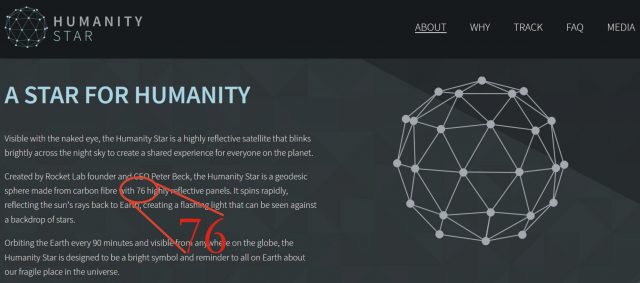
aNewDomain — After it secretly launched its so-called Humanity Star into orbit last month, New Zealand-based Rocket Lab was all over the headlines. And not because humanity was so overwhelmingly in love with the space borne disco ball, either.
The three-feet wide globe and its sun-reflecting triangular panels will be the brightest object in the sky at least until fall, according to company execs. Astronomers don’t doubt it, and several have come out publicly to sharply criticize bother the effort and the disco ball. The problem, they say, is light pollution.
It’s not the only problem critics have.
The Humanity Star is “just another invasion of my personal universe, another flashing item asking for eyeballs,” wrote Columbia University astro-biologist Caleb Scharf in a scathing Scientific American piece last week. The article, called ‘Twinkle, Twinkle, Satellite Vermin,’ was scathing.
Rocket Lab’s “jamming (of) a brilliantly glinting sphere into the heavens,” Scharf continued, “is infesting” the night sky with its garishness.
Like “a big flashing strobe-light to a polar bear, ” he wrote, “or emblazoning my company slogan across the perilous upper reaches of Everest,” the Humanity Star is “similarly abusive.”
Scharf may or may not have a point light, but pollution and attention-grabbing kitschiness are his objections, not mine.
 My objection has to do purely with this company’s’ math — its bad math, I mean.
My objection has to do purely with this company’s’ math — its bad math, I mean.
Bad math is bad form for anyone with a brain, really. But for a space tech company run by rocket scientists? I mean, really now.
Bad math rising
What are my math issues with the Rocket Lab people?
They are three-fold.
First off, there’s the fact that Rocket Lab came out the gate recently by getting the number of panels on the satellite wrong. As you can see from the graphic, at right, from its website, it incorrectly claims that Humanity Star has 65 panels.
Everyone knows that the polyhedral shape of the Humanity Star has 80 side faces. (To be precise, as mathematicians who gather at this site have pointed out, it really is a pentagonal orthobirotunda polyhedron. More on that in a second.)
Yes, if you you remove the bottom six side panels in order to give it a flat bottom, that leaves 74 panels. But the star has a hexagonal panel over that bottom, so that makes 75 panels.

I never expected such a rookie math error from a space tech company. Surprised, I tried to get to the bottom of what went wrong here. I contacted the firm. I wanted answers.
But even though I described in detail why their 65-panel number was so nuts, no answers came. There was no response, at all.
I suppose we should be satisfied that the firm did finally fix the graphic. Just a few days ago, on Feb. 7, the firm quietly made the fix as you can see on its site now — and in the image above left.
But if the firm thought it could rewrite the history of its own math quietly, with no one but me and Internet Archive nerds noticing, it was sadly — and mathematically — mistaken. Have these folks really never heard of the Wayback Machine on the Internet Archive?
And the company’s sneaky attempt to hide its math issues made another miscalculation evident, too.
Look at the official photo of the Humanity Star and compare it with the one on the site (bottom). Some people might not think the difference is so obvious, but you will:Obviously one of them is a pentakis icosidodecahedron. And one isn’t.
Clearly, the official photo of the Humanity Star (at top) is turned 36 degrees with respect to the upper side as compared to how it is rendered on the website.
Talk about sloppy.
Sure, polluting the sky with light and silly theatrics probably isn’t the best of moves. But is it too much to expect the geniuses at this spacetech company to know their icosidodechadrens from their pentagonal orthibundras?
I don’t think so either.
I mean, please. It isn’t as if math is rocket science or something …
For aNewDomain, I’m Dirk Huylebrouck.
Update: As it turns out, Rocket Labs has modified the number of panels on the Humanity Star yet again. Now it doesn’t say 65, nor 75, but 76. In that case, a pentagon, and not just a single hexagonal panel, must be what is replacing the six triangles at the base. Or so it will seem — until the next count.














